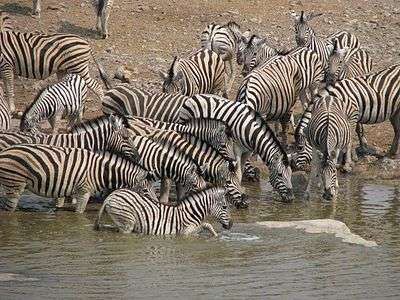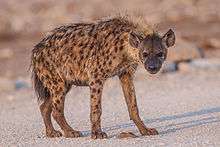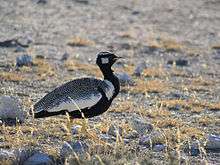Etosha National Park
Etosha National Park is the second largest of Namibia's game reserves (after Namib-Naukluft National Park). It spans 20,000 km² in the Four-O region. The park surrounds the Etosha salt pan, which attracts animals, particularly in the drier winter months, because it is a source of water in a very dry land.

Understand
Its name means "big white place", referring to the Etosha Salt Pan.
All facilities inside the park are run by Namibia Wildlife Resorts, a company owned by the Namibian Government.
History
Landscape
The park surrounds the Etosha salt pan, which attracts animals, particularly in the drier winter months, because it is a source of water in a very dry land.
Flora and fauna
Wildlife that can be seen here include: Rhinos, Lions, Zebra, Giraffes, Gemsbok, Springbok, Wildebeest, Elephants, and Jackals.
Climate
Get in
To visit Etosha, one needs a vehicle. Visitors are not permitted to wander around the park (except in the enclosed camping/hotel areas) on foot. The B1 (from either Oshakati or Tsumeb) brings you to the park's eastern gate at Namutoni. The C38, from Outjo bring you to the park's southern gate.
There are also several safari companies operating from Windhoek and Swakopmund which offer tours of varying length in Etosha. Safari companies are also allowed to enter the western part of the park which is closed to private visitors.
Fees and permits
Get around
As mentioned above, you need a vehicle to get around the park. The roads are all well-graded gravel, so there is no need to have a four-wheel drive. Since the dust generated by traffic is damaging to the environment, the speed limit is 60 km/h (37 mph). Be careful when driving on gravel roads especially when braking as there is very little traction available and one can skid very easily. Remember to fuel up in advance as the fueling stations are only at the camps and distances in Namibia are deceptive.
See

- Animals! Throughout the park, particularly at watering holes, of which there are many.
- Rest Camp watering holes At all three rest camps, there is are watering holes just outside the perimeter fence. At night they are lit with flood lights and visitors can sit and watch as the animals come down to drink, flirt and occasionally fight well into the night. They are ideal places to wander down to with a sundowner after getting back from a days game spotting.
Visitors are not allowed out of the rest camps after sunset so the waters holes can provide the opportunity to continue watching the animals after dark.
Do
What else to do then see the wildlife! From every hotel there are possibilities to do a game drive, be sure to bring your binoculars as some animals (like lions or cheetahs) can only be watched when distance is kept. Also when close to animals be very quiet, most animals will be scared by the slightest noise.
The best time to easily see a lot of wildlife is in the afternoon around 15:30, beware however that most hotels and lodges close their gates at 6 in the evening. When you want to visit the park after the gates are closed you will need a special guide to accompany you.
Buy
A good map that has all the water holes that tells you where to see the animals you may want to see
Eat
Drink
Sleep
There are five designated rest camps for visitors, enclosed by walls and fences. Namutoni, Halali and Okaukejo have camping, and most offer petrol stations, pools and shops for those things you forgot. The gates for camps open at sunrise and close at sunset. You are not allowed outside of a camp during night. Bush camping is not permitted. All lodges and campsites inside of the park can be booked through Namibia Wildlife Resorts.
- Namutoni (at the east gate of the park). This is on the site of an old German fort which was burned down many years ago in a raid by the Ovambo people from the north. Today the fort is a hotel. There is also a shop where you can buy food and basic supplies.
- Halali (South of the pan and situated about half way between the other two eastern camps). This has the most impressive floodlit water hole with a viewing platform - you can walk down after setting up camp and sit here at sunset, drink a sundowner and watch the animals come down to drink.
- Okaukuejo (at the south entrance to the park). There are small huts available, as well as a restaurant and pool. Be sure to have a look at the waterhole around midnight, you can often see rhinos even during wet season. This has the best layout among all the camps and the best waterhole for sitting down and watching animals.
- Dolomite Camp (at the western entrance to the park). It is a camp that is fairly new and offers luxury accommodation full board. The camp is situated on the top of a Koppie.
- Onkoshi (in the northeast corner of the park). This camp is located on the edge of the Etosha pan and features fifteen huts built on elevated wooden decks.
Stay safe

Stay in your car; wild animals can be dangerous. There are plenty of picnic spots around the park where one can alight from your vehicle, but these are not all fenced so be on the lookout for animals. At night, jackals may walk around your campsite, they will usually flee when they see you but be careful, some jackals carry rabies.
Although all campsites are fenced, do not sleep outside, especially not on the benches surrounding the waterholes. The fence is not high there and not really an obstacle for a lion.
Etosha is in the malaria zone, so take appropriate precautions.
Go next
North-west of Etosha the Caprivi Strip offers more game parks and is en route to the Victoria Falls.